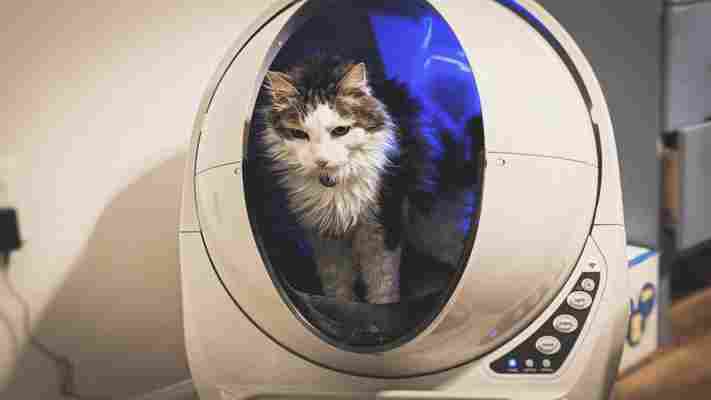Ask any person living with cats about the worst part of their cohabitation, and their answer will likely relate to scooping litter. It sucks, especially in a multi-cat home, and even more so in a small apartment.

Then I got my hands on the Litter-Robot 3 Connect . Long story short: it has been an absolute game-changer for my home, and I can’t imagine ever going back to a regular old litter box. Even if the $499 price ($449 for the wi-fi-less version) is a tough pill to swallow, the convenience of almost never having to think about litter is worth it.
I took my time before writing this review because I wanted to make sure the experience actually held up over an extended period. It’s been four months since I received my unit, and with regular usage by two cats, it’s largely been smooth sailing since.
I should add the disclaimer that I have not tested any other automated litter boxes. I chose to try the Litter-Robot due to the length of time it’s been on the market, but I can’t tell you whether the Litter-Robot is the best such device. I also can’t guarantee your cats will get used to it. I can only confirm that in my home, it’s performed its job with aplomb.
If you haven’t seen a Litter-Robot in action, here’s how it works:
Add clumping litter into the basin.
Wait for your cat to poop or pee.
After 7 minutes (or 3 or 15 minutes, depending on your settings), watch as the Litter Robot‘s ‘globe’ rotates to sift through the litter and then dumps clumps of pee and poop into a receptacle bag underneath the globe.
About once or twice a week, depending on how many cats you have, dump out the collected litter and add fresh litter to the machine.
Clean the globe (not as hard as it seems) and replace the carbon filter every few months.
This official video might make it clearer:
Despite the marketing talk, the promises above largely reflect my own experience.
I’d learned of the Litter-Robot shortly after we adopted our first cat (Parsnip, a languorously loveable lapcat), but had largely dismissed it for its price. After getting our second cat (Pomeline, a fabulous fireball of a feline) and moving to a smaller apartment, my girlfriend and I thought we could use a break from all the scooping (have I mentioned scooping is no fun?).
Be warned: this thing is huge, and more so if you get the optional ramp (Parsnip is an old man and needs a little help). The Litter-Robot takes up a massive footprint compared to a regular litter box. But in practice, this ended up being less of an issue than I thought it would be.


After all, having two cats used to mean having two litter boxes. Like many cats, Parsnip and Pomeline preferred to use their own designated potty. But because the Litter-Robot automatically cleans itself after use, Parsnip and Pomeline have had little issue with sharing.
If anything, the cats seem to prefer sharing the Litter-Robot to having their separate litter boxes adjacent to one another, and the Litter-Robot‘s footprint does not seem so large when you consider one unit can replace two or more regular litter boxes.
It’s also helped avoid having accidents outside the litter box. Parsnip is particularly picky; if the litter box was dirty when nature called, he would often decide to take his business elsewhere. Pomeline not being familiar with the proper use of a bathtub, occasionally believed it to be a giant litter box. But since they’ve acclimated to the Litter-Robot, we have suffered far fewer of these accidents.
The Litter-Robot has helped our home smell cleaner too. Despite the fact the litter is stored within the unit, used litter is sealed under the globe with a carbon filter that effectively traps smells. As a testament to this effectiveness, the Litter-Robot has been positioned right next to my bed (again, small apartment) this whole time, rarely revealing unpleasant scents unless someone just used the bathroom.
More importantly, it’s much less smelly than our old pair of litter boxes (and we’ve been through a few different kinds), even though we scooped multiple times a day. Comparing the Litter-Robot to a regular litter box feels like comparing a flushable toilet to a porta-potty.
As a bonus, the Litter-Robot has also meant less litter falls on my floor due to scooping, and the optional ramp catches litter my cats might otherwise track around the home. As another bonus, our dog Ozzie has fewer opportunities to eat litter, a rather unseemingly vice of hers.
The Wi-Fi features of the Connect version I tested enough are useful enough to be worth the $50 premium. The app’s main use is sending a notification to your phone when the litter box is full or if a cycle was interrupted (such as if one of the cats had tried to get in mid-rotation). You can also track your cat’s bathroom habits, although this is much less useful when you have two furbabies, as the Litter-Robot can’t tell them apart. Adding a microchip sensor to a future model could help improve this functionality.
There were occasional hangups. Most commonly, the built-in scale sometimes would not register when someone used the bathroom. I notice it happen maybe once or twice a week.
No big deal. Simply press the cycle button on the machine or in the app and go about your business; it’s still much better than the mess of constant scooping.
On another occasion, some debris had gotten stuck in the device’s pinch sensor (which helps prevent your cat from getting, well, pinched). This required me to take apart the unit — no screws needed — to dislodge the debris.
I should also note that you will need to use a litter that clumps well and isn’t too light (the latter to help the weight sensor work properly). I’ve used Dr. Elsey’s (clay) and World’s Best Litter (corn) without a hitch.
Lastly, you might want to give it at least a couple of weeks for your cats to get fully acclimated. Although Pomeline got used to the Litter-Robot right away, it took Parsnip a couple of weeks to get the hang of having to climb a ramp in order to use a bathroom; I often had to carry him into the chamber while he figured things out. And there’s always the risk your cats just won’t get used to it.
But those caveats have barely registered in the long term. Yes, you’ll still have to toss the litter bag once or twice a week and clean the full unit every few months, but that’s still far less regular upkeep and daily interaction with poop than with a regular litter box.
The Litter-Robot turned one of the most unpleasant parts of living with cats into something I rarely even think about. If you can afford to spend $499 for the added convenience, cleanliness, and peace of mind of never having to scoop again, this fanciest of litter boxes is well worth the price of admission.

